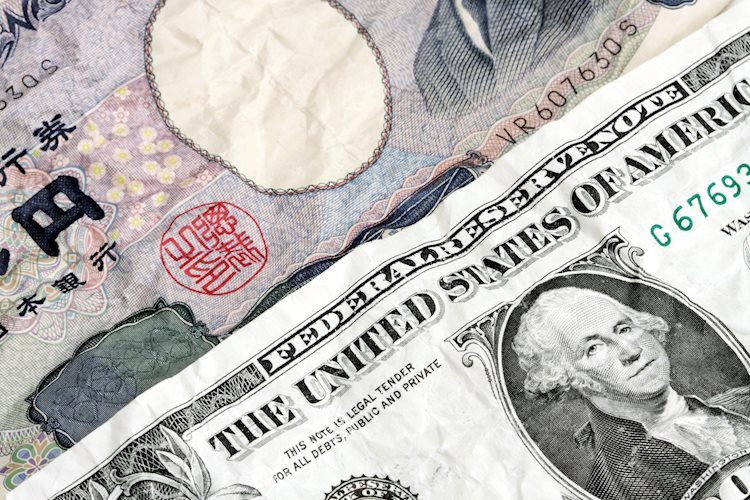- The Japanese Yen attracts follow-through selling amid wavering BoJ rate hike expectations.
- The widening US-Japan yield differential and a positive risk tone also undermine the JPY.
- Intervention fears, along with geopolitical risks, could offer support to the safe-haven JPY.
The Japanese Yen (JPY) dropped to a near six-month low against its American counterpart during the Asian session on Tuesday amid doubts over the likely timing when the Bank of Japan (BoJ) will hike rates again. Furthermore, the prospects for slower rate cuts by the Federal Reserve in 2025 remain supportive of elevated US Treasury bond yields, widening the US-Japan yield differential and contributing to driving flows away from the lower-yielding JPY.
Apart from this, a generally positive risk tone is seen as another factor undermining the safe-haven JPY. This, along with the emergence of some US Dollar (USD) buying, lifts the USD/JPY pair above the 158.00 mark. That said, BoJ Governor Kazuo Ueda left the door open for a rate hike in January or March. Furthermore, speculations that Japanese authorities might intervene in the market to prop up the domestic currency could limit the JPY losses.
Japanese Yen remains depressed amid BoJ uncertainty, despite intervention fears
- The Bank of Japan last month opened up the possibility of waiting longer before the next rate hike, citing uncertainty over US President-elect Donald Trump’s economic policies, which continues to undermine the Japanese Yen.
- Trump denied a Washington Post story that his administration will pursue a less aggressive tariff regime and will only target certain sectors in imposing trade tariffs, instead of the broad tariffs promised during campaigning.
- BoJ Governor Kazuo Ueda said on Monday the central bank will raise interest rates further if the economy continues to improve, though he stressed the need to consider various risks when deciding how soon to pull the trigger.
- Furthermore, the broadening inflationary pressures in Japan keep the door open for a potential BoJ rate hike in January or March, pushing the yield on benchmark 10-year Japanese government bonds to its highest level since July 2011.
- Meanwhile, the 10-year US Treasury yield shot to a multi-month peak in the wake of the Federal Reserve’s hawkish shift, projecting only two quarter-point rate cuts in 2025 amid still elevated inflation in the world’s largest economy.
- The resultant widening of the US-Japan interest rate differential and the prevalent risk-on mood do little to provide any respite to the safe-haven JPY or hinder the USD/JPY pair’s positive move back above the 158.00 round figure.
- Japan’s Finance Minister Katsunobu Kato was out with some verbal intervention this Tuesday and said that the government will take appropriate action against excessive FX moves, including those driven by speculators.
- Traders now look to Tuesday’s US economic docket – featuring the ISM Services PMI and JOLTS Job Openings – for some impetus ahead of the FOMC minutes and the US Nonfarm Payrolls on Wednesday and Friday, respectively.
USD/JPY technical setup supports prospects for further gains beyond 159.00 mark
From a technical perspective, a sustained move beyond the 158.00 mark could be seen as a fresh trigger for bullish traders and support prospects for additional gains. The constructive outlook is reinforced by the fact that oscillators on the daily chart are holding comfortably in positive territory and are still away from being in the overbought zone. Hence, a subsequent strength towards the 159.00 round figure, en route to the 159.45 intermediate hurdle and the 160.00 psychological mark, looks like a distinct possibility.
On the flip side, the 158.00 round figure now seems to protect the immediate downside ahead of the 157.55-157.50 region. Any further pullback might now be seen as a buying opportunity and remain limited near the 157.00 mark. Some follow-through selling, however, could drag the USD/JPY pair to the 156.25 intermediate support en route to the 156.00 mark. The latter should act as a pivotal point, which if broken decisively, might negate the positive bias and pave the way for a deeper corrective decline.
Bank of Japan FAQs
The Bank of Japan (BoJ) is the Japanese central bank, which sets monetary policy in the country. Its mandate is to issue banknotes and carry out currency and monetary control to ensure price stability, which means an inflation target of around 2%.
The Bank of Japan embarked in an ultra-loose monetary policy in 2013 in order to stimulate the economy and fuel inflation amid a low-inflationary environment. The bank’s policy is based on Quantitative and Qualitative Easing (QQE), or printing notes to buy assets such as government or corporate bonds to provide liquidity. In 2016, the bank doubled down on its strategy and further loosened policy by first introducing negative interest rates and then directly controlling the yield of its 10-year government bonds. In March 2024, the BoJ lifted interest rates, effectively retreating from the ultra-loose monetary policy stance.
The Bank’s massive stimulus caused the Yen to depreciate against its main currency peers. This process exacerbated in 2022 and 2023 due to an increasing policy divergence between the Bank of Japan and other main central banks, which opted to increase interest rates sharply to fight decades-high levels of inflation. The BoJ’s policy led to a widening differential with other currencies, dragging down the value of the Yen. This trend partly reversed in 2024, when the BoJ decided to abandon its ultra-loose policy stance.
A weaker Yen and the spike in global energy prices led to an increase in Japanese inflation, which exceeded the BoJ’s 2% target. The prospect of rising salaries in the country – a key element fuelling inflation – also contributed to the move.
Read the full article here


